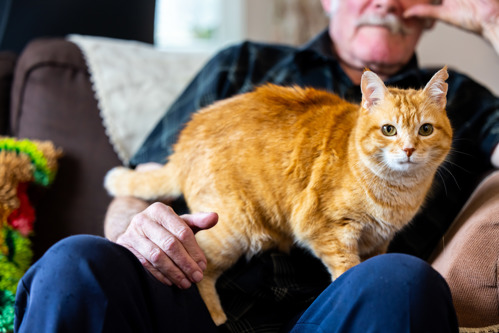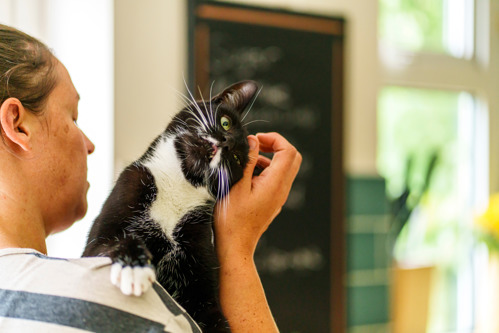Are you allergic to cats but want one? Discover how to have a cat when you’re allergic
Being allergic to cats is quite common among humans. Many people suffer with symptoms such as sneezing, itchy skin, watering eyes, coughing and wheezing whenever a cat is nearby.
Sadly this can prevent caring cat lovers from owning a cat of their own. Even worse, it can result in them having to give up a beloved pet to charities such as Cats Protection.
If you do own a cat when you’re allergic, it can still affect your ability to form a close bond with your pet. You may try to maintain a safe distance to keep the sneezing at bay.

But a cat allergy doesn’t necessarily mean you can’t get a cat. There’s a lot of confusion around the exact cause of the symptoms and how to reduce their effects. Once you know the facts, there are lots of things you can try.
Myths about cat allergies
Are cat allergies caused by cat hair?
Many people think that cat hair is the cause of their sneezing when they're allergic, but it’s actually what’s on the hair that’s the problem. Cats’ saliva contains a protein called Fel d 1. This sticks to their fur and skin when they clean themselves with their tongues. It’s this protein that most cat allergy sufferers have a reaction to. Unfortunately it’s spread around your home when your cat sheds their fur and dead skin cells.
Can you be allergic to some cats and not others?
Different cats produce varying levels of Fel d 1. Allergy sufferers may find that they are allergic to specific cats and not others. Everyone’s sensitivity level to this allergen is different. If you think you’re allergic to cats but want one, try meeting some cats first to see if you have a reaction. Keep in mind that many people with an allergy to cats are also allergic to other things, such as pollen. It might be a good idea to meet your potential new cat in the summer when your pollen symptoms are more pronounced. You can then better gauge how your allergies will be affected.

Which are the best cat breeds for people with allergies?
While levels of Fel d 1 do vary, every cat produces it. There’s no such thing as a hypoallergenic cat. Some people believe that certain breeds of cat, such as hairless Sphynx cats, are the best cats for allergies, but this isn’t true. Hairless cats still lick themselves to stay clean, causing Fel d 1 to stick to their skin. When they shed dead skin cells called dander, the allergen can spread around the home.
Can cat allergies go away with exposure?
Some people believe that you can build immunity to cat allergies and that the more time you spend with cats, the less severe your allergy will become. But there’s no evidence to support this. This doesn’t mean you need to avoid cats altogether though. There are some simple steps you can take to manage your allergy and still enjoy some cat companionship.
How to manage cat allergies
It can be easy to think that it’s impossible to have a cat if you’re allergic. But by following these steps, you can keep your furry friend and reduce the amount of sniffles in your home.
- Ask your doctor about antihistamine tablets and nasal sprays to ease your symptoms
- Groom your cat outdoors and wipe them with a damp cloth or cat-safe cleanser to remove allergens
- Avoid letting your cat lick your skin or clothes and always wash your hands after petting your cat
- Regularly wash your cat’s bedding, toys and litter tray. Fel d 1 can be found in their pee too
- Ventilate your home by opening windows for an hour each day, or use an air purifier. Avoid placing cat beds and litter trays close to air vents
- Vacuum regularly using a cleaner with a high-efficiency particulate air (HEPA) filter. This limits the amount of allergen released back into the air
- Avoid letting your cat into your bedroom, as allergies can become worse at night
- Try feeding your cat special food designed to help with cat allergies
How do antihistamines work for cat allergies?
In people with a cat allergy, when the body detects the Fel d 1 protein it produces histamine. This is normally only released when the body detects something harmful, such as an infection. But if you are allergic to cats then the normally harmless Fel d 1 protein can be mistaken for a threat.
To try to protect your body from the allergen, histamine causes your blood vessels to expand and your skin to swell. This results in the typical allergy symptoms of itchy eyes, a running or blocked nose and sneezing.
Antihistamines are a type of medication that block the receptors in your cells that histamine binds to. This prevents your symptoms before they occur or reduces their severity.



